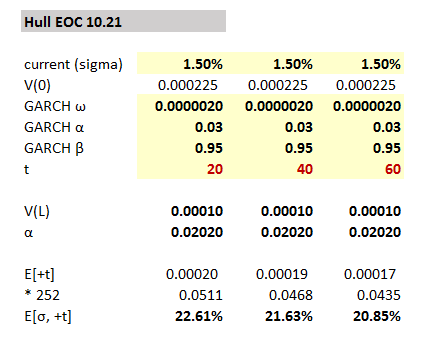gargi.adhikari
Active Member
Hi,
In Reference to HULLCH10_Question 10.5:
What is Simplified Approach Equation 10.4 the the solution is referring to here ..?

Question 10.5: Suppose that observations on an exchange rate at the end of the past 11 days have been 0.7000, 0.7010, 0.7070, 0.6999, 0.6970, 0.7003, 0.6951, 0.6953, 0.6934, 0.6923, and 0.6922. Estimate the daily volatility using both approaches in Section 10.5.
Answer: The standard formula for calculating standard deviation gives 0.547% per day. The simplified approach in equation (10.4) gives 0.530% per day.

In Reference to HULLCH10_Question 10.5:
What is Simplified Approach Equation 10.4 the the solution is referring to here ..?


Question 10.5: Suppose that observations on an exchange rate at the end of the past 11 days have been 0.7000, 0.7010, 0.7070, 0.6999, 0.6970, 0.7003, 0.6951, 0.6953, 0.6934, 0.6923, and 0.6922. Estimate the daily volatility using both approaches in Section 10.5.
Answer: The standard formula for calculating standard deviation gives 0.547% per day. The simplified approach in equation (10.4) gives 0.530% per day.





 (if ever!). Have you plugged this into Mathematica? That's what I do with difficult calculus, it shows step-by-step. Their alpha is really amazing, it's saved me so many times with calculus, in particular integrals, see
(if ever!). Have you plugged this into Mathematica? That's what I do with difficult calculus, it shows step-by-step. Their alpha is really amazing, it's saved me so many times with calculus, in particular integrals, see 